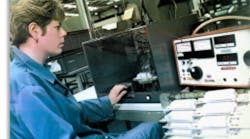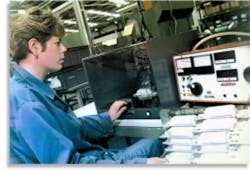A quick retreat often follows, with discussions that aim toward reducing an erroneously perceived time and cost burden, often quoting ISO 9000 procedures and focusing on sample testing as a suitable solution. This approach tends to exclude a closer evaluation of the concept of 100% testing, which is to ensure and maintain product safety.
Essentially, batch sampling is designed to determine whether or not type test and build instructions are being maintained via a set of working standards and relies on a traceable scientific relationship between the sample and the rest of the batch. It is assumed that if the sample shows conformance, then the rest of the batch also complies. In many manufacturing processes, sampling may be satisfactory. But when the issue is customer safety, can anyone take this risk?
To maintain a proper scientific relationship back to the type-approved product, the batch sample must undergo type test. This could involve the following:
- External test houses or the transfer of the sample to a dedicated, in-house test laboratory.
- Skilled and expensive labor.
- Specialized and usually high-cost test equipment.
- Complex, time-consuming test routines.
- Possible destruction of the test sample.
Using a typical batch sampling routine as an example, the following scenario can be envisaged. Risk analysis determines a procedure for testing one sample product for every 100 that come off the assembly line. The sample is sent to the laboratory where it undergoes rigorous testing and fails.
Strictly speaking, production now should be halted until the cause and extent of the fault are identified. This should include recalling and testing not only the remaining 99 items of the particular batch, but also any items produced since the sample was taken.
The cost of this exercise can be worked out in terms of time, labor, and discarded packaging for products in the factory and those already in the field. Testing now requires costly skilled labor. Then there are rework costs including time, labor, and perhaps parts. This is followed by lost production, because it is highly unlikely that all items are salvageable, and late delivery penalties.
True, this hypothetical example is a worst-case scenario that only applies if the sample fails. On the other hand, would anyone feel comfortable knowing that an electric drill or kitchen appliance has only a one in 100 certainty of not causing electrocution?
Similarly, the manufacturers of finished products must know that the safety-critical components used to assemble a product are satisfactory, preferably before being incorporated into the product. Against this background, an increasing number of manufacturers of electrical products check supplied components before or during their own product assembly.
These companies implicitly reject batch sampling as a viable test method, instead replacing it with 100% component testing. Testing all components identifies problems and defects before assembly and increases confidence in finished products. It also reduces the likelihood of product rework and allows the cost of failures to be recovered more easily from the supplier.
By completing the manufacturing cycle with 100% product testing, significant information can be gathered and used to improve and refine manufacturing processes and techniques. Identifiable reasons for product failures can be highlighted and quickly acted upon. Even simple fault counters can indicate particular areas of production that may require further investigation.
But what does 100% testing really mean? Clare’s experience in electrical safety testing confirms that there are three main tests to ensure product safety:
- High current ground-bond measurement.
- High-voltage flash test.
- Insulation resistance measurement.
A number of concerns have been raised against such an approach, usually on the basis of time and cost, but these can be countered.
Regarding time, misconceptions arise between type testing requirements and the established practices for 100% production-line testing. For example, some comprehensive test stations can apply all three basic safety tests in cycles as short as two to three seconds per product. Referring back to the earlier example, all 100 products could have been tested in five minutes.
In terms of cost, equipment can be expensive. But there are a number of reasonably priced production-line test systems available. With simple-to-use setup and control features, these test stations can be incorporated easily into the production environment without the need for highly skilled labor.
An Example
Given the tremendous variety in size, shape, and performance characteristics of electrical products now manufactured, customized electrical safety testing solutions often need to be developed to meet specific production-line requirements. One such example is a project that safety testing specialists at Clare Instruments recently developed for Transtar, a lighting equipment manufacturer.
For more than 50 years, Transtar has been a leading manufacturer of control gear for the lighting industry. One of the company’s most recent additions is a low-power ballast for low-pressure sodium lamps, which allows users to install a high power factor unit without connecting a separate capacitor across the AC input.
As part of this commitment to product development and user satisfaction, Transtar recently introduced testing facilities for its full range of 50-Hz control ballasts. These electromagnetic control ballasts are the drive units for gas discharge lamps and comprise an iron core with a winding of insulated copper wire.
The electrical-grade steel lamination stack is attached to a mild steel base plate to which terminal blocks are fixed. The whole unit is vacuum impregnated with an unsaturated polyester resin system to improve reliability, reduce noise, and ensure high thermal and insulation performance with good impact resistance.
Testing Demands
When used in luminaries, the ballast is grounded through the base plate. For that reason, effective ground bond and flash tests were required to ensure the electrical safety of the unit and prove that reliable contact had been established between the lamination stack and the base plate.
However, the presence of the external resin coating provided a problem, particularly with the ground bond test. This test ensures the proper and secure connection of the metal case to the AC power ground reference using test probes and relies on all individual external metal surfaces being tested—a process rendered almost impossible by the tough polyester resin coating.
Tried and Tested
A customized solution was fully integrated into end-of-line testing. Both the electrical safety and functional parameters of the product needed to be checked.
The Clare design team configured a system using various test modules from the company’s range of products. However, the major concern was applying the tests to the product in a quick, simple, and operator-friendly manner.
The use of a safety enclosure is essential for such applications. It provides operator safety and product location and can be readily interfaced to the test instrument for initiating automatic test sequencing.
Providing the necessary fixtures within the enclosure to automatically apply the test probes to the various test points was a major challenge. Because of the resin coating on the ballast, pneumatically driven test heads were the most appropriate solution. They had the necessary force to penetrate the resin coating and ensure reliable contact to the lamination stack, mounting plate, and ballast winding terminals.
Extensive research and experimentation were required to develop the optimum probe-tip design. This not only had to satisfy the criteria for making effective contact through the resin to the base metal, but also had to stand up to the high-volume throughput of busy production cells.
Other features incorporated into the overall design provided clear identification of faulty product through audible and visual warnings. Isolation of all test outputs also was achieved automatically whenever the enclosure was opened.
The end result is a fully integrated test and measurement system that provides quick and simple testing of finished ballast control products coupled with operator safety. This gives Transtar major benefits in the quest for maximum production efficiency at minimum unit cost.
About the Author
Greg Brown is the custom products manager at Clare Instruments Ltd. near Worthing, U.K. He joined the company in 1975 to establish a product development department.
Clare Instruments U.S., 6304 Benjamin Rd., Suite 506, Tampa, FL 33634, 813-886-2775, e-mail: usa@clareinstruments.com
Return to EE Home Page
Published by EE-Evaluation Engineering
All contents © 2003 Nelson Publishing Inc.
No reprint, distribution, or reuse in any medium is permitted
without the express written consent of the publisher.
May 2003

